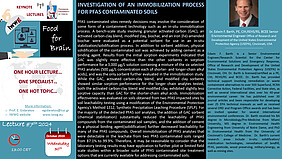Ο Ομ. Καθηγητής του Πολυτεχνείου Κρήτης κ. Ευάγγελος Γιδαράκος, συνεχίζει και φέτος την υλοποίηση διαδικτυακών διαλέξεων σε φλέγοντα θέματα διαχείρισης αποβλήτων, με τίτλο "FOOD for BRAIN".
Την Τετάρτη 30 Οκτωβρίου 2024 και ώρα 13:00 CET (14:00 ώρα Ελλάδος) ο Dr. Edwin F. Barth από την United States Environmental Protection Agency (USEPA), ως προσκεκλημένος εισηγητής της δράσης "FOOD for BRAIN" για τον Οκτώβριο, θα πραγματοποιήσει ομιλία που θα εστιάσει στη «Διερεύνηση διαδικασίας ακινητοποίησης για εδάφη ρυπασμένα με PFAS».
Συμμετοχή μπορεί να πραγματοποιηθεί μέσω του ακόλουθου συνδέσμου:
Τίτλος
INVESTIGATION OF AN IMMOBILIZATION PROCESS FOR PFAS CONTAMINATED SOILS
Περίληψη
PFAS contaminated sites remedy decisions may involve the consideration of some form of a containment technology such as an in-situ immobilization process. A bench-scale study involving granular activated carbon (GAC), an activated carbon-clay blend, modified clay, biochar, and an iron (Fe)-amended biochar were evaluated as a potential sorbent for use in an in-situ stabilization/solidification process. In addition to sorbent addition, physical solidification of the contaminated soil was achieved by adding cement as a binding agent. Results from the initial sorption experiments indicated that GAC was slightly more effective than the other sorbents in sorption performance for a 3,000 μg/L solution containing a mixture of the six selected PFAS analytes (500 μg/L concentration each of shorter- and longer-chain alkyl acids), and was the only sorbent further evaluated in the immobilization study. While the GAC, activated carbon-clay blend, and modified clay sorbents showed similar sorption performance for the longer chain analytes tested, both the activated carbon-clay blend and modified clay, exhibited slightly less sorptive capacity than GAC for the shorter-chain alkyl acids. Immobilization effectiveness was evaluated on soils obtained from two PFAS impacted sites by soil leachability testing using a modification of the Environmental Protection Agency’s Method 1312, Synthetic Precipitation Leaching Procedure (SPLP). For the majority of the detected PFAS soil analytes, the addition of GAC sorbent (chemical stabilization) substantially reduced the leachability of PFAS compounds from the contaminated soil samples, and the addition of cement as a physical binding agent(solidification) further decreased leachability for many of the PFAS compounds. Overall immobilization of PFAS analytes that were detectable in the leachate from two PFAS contaminated soils ranged from 87.1% to 99.9%. Therefore, it may be reasonable to consider that the laboratory testing results may have application to further pilot or limited field scale studies within a broader suite of PFAS contaminated site treatment options that are currently available for addressing contaminated soils.
Βιογραφικό
Dr. Edwin F. Barth, PE, CIH,REHS/RS, BCEE Senior Environmental Engineer Office of Research and Development of the United States Environmental Protection Agency (USEPA), Cincinnati, USA
Edwin F. Barth is a Senior Environmental Engineer/Research Scientist for the Center for Environmental Solutions and Emergency Response, Office of Research and Development of the United States Environmental Protection Agency (USEPA) in Cincinnati, OH. Dr. Barth is licensed/certified as a PE, CIH, REHS/RS and BCEE. Dr. Barth has provided technical support involving remediation or waste containment alternatives to over 500 Superfund, RCRA Corrective Action, Federal Facilities, and State sites, as well as several international sites over his 40-year environmental career. He has published over 30 journal articles and been responsible for developing over 25 EPA technical manuals as well as received several ORD and Program Office awards and has been an invited speaker for several international environmental conferences. Dr. Barth received his BA degree in Microbiology/Pre-Medicine from Miami University, MS degree in Environmental Health Engineering from University of Notre Dame, and PhD in Environmental Health from the University of Cincinnati’s College of Medicine. Dr. Barth’s current research areas include in-situ solidification/stabilization technologies, remediation of landfill, PFAS, pesticide, wood preserving, military/energy, as well as mining sites.
















